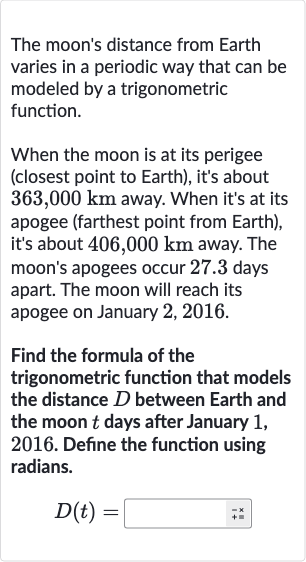AI tutor
Welcome to Bytelearn!
Let’s check out your problem:

The moon's distance from Earth varies in a periodic way that can be modeled by a trigonometric function.When the moon is at its perigee (closest point to Earth), it's about away. When it's at its apogee (farthest point from Earth), it's about away. The moon's apogees occur . days apart. The moon will reach its apogee on January , .Find the formula of the trigonometric function that models the distance between Earth and the moon days after January , . Define the function using radians.
Full solution
Q. The moon's distance from Earth varies in a periodic way that can be modeled by a trigonometric function.When the moon is at its perigee (closest point to Earth), it's about away. When it's at its apogee (farthest point from Earth), it's about away. The moon's apogees occur . days apart. The moon will reach its apogee on January , .Find the formula of the trigonometric function that models the distance between Earth and the moon days after January , . Define the function using radians.
- Determine Amplitude and Period: To find the trigonometric function that models the distance between Earth and the moon, we need to determine the amplitude, period, phase shift, and vertical shift of the function.
- Calculate Vertical Shift: The amplitude of the function is half the distance between the maximum and minimum values. The maximum distance is at apogee km and the minimum distance is at perigee km.
- Convert Period to Radians: The vertical shift is the average of the maximum and minimum values, which is also the midline of the function.
- Find Angular Frequency: The period of the function is the time it takes for the moon to go from one apogee to the next, which is days. Since we are defining the function using radians, we need to convert the period into radians. The moon completes a full cycle radians in one period . days
- Determine Phase Shift: To find the angular frequency (), we use the formula .
- Define Trigonometric Function: The phase shift will be determined by the fact that the moon reaches its apogee on January , , which is day after January , . Since the trigonometric function starts at its maximum at , we need to shift the function to the right by day.Phase shift = day
- Define Trigonometric Function: The phase shift will be determined by the fact that the moon reaches its apogee on January , , which is day after January , . Since the trigonometric function starts at its maximum at , we need to shift the function to the right by day.Phase shift = dayNow we can define the trigonometric function using the cosine function, which starts at its maximum value. The general form of the function is:Where is the phase shift in radians. Since the phase shift is day, we need to convert this to radians using the angular frequency . day
- Define Trigonometric Function: The phase shift will be determined by the fact that the moon reaches its apogee on January , , which is day after January , . Since the trigonometric function starts at its maximum at , we need to shift the function to the right by day.Phase shift = dayNow we can define the trigonometric function using the cosine function, which starts at its maximum value. The general form of the function is:Where is the phase shift in radians. Since the phase shift is day, we need to convert this to radians using the angular frequency . dayPutting it all together, we get the function:
